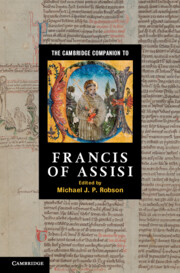Book contents
- Frontmatter
- Introduction
- PART I Francis of Assisi
- 1 Francis and the Franciscan movement (1181/2–1226)
- 2 The writings of Francis
- 3 The Rule and life of the Friars Minor
- 4 Francis and his hagiographical tradition
- 5 Voluntary simplicity: the attitude of Francis towards learning in the early biographies
- 6 Francis and the historiographical tradition in the order
- 7 Francis and Clare and the emergence of the Second Order
- 8 Francis and the encounter with the sultan (1219)
- 9 Francis and creation
- PART II The heritage of Francis of Assisi
- Index
4 - Francis and his hagiographical tradition
from PART I - Francis of Assisi
Published online by Cambridge University Press: 28 November 2011
- Frontmatter
- Introduction
- PART I Francis of Assisi
- 1 Francis and the Franciscan movement (1181/2–1226)
- 2 The writings of Francis
- 3 The Rule and life of the Friars Minor
- 4 Francis and his hagiographical tradition
- 5 Voluntary simplicity: the attitude of Francis towards learning in the early biographies
- 6 Francis and the historiographical tradition in the order
- 7 Francis and Clare and the emergence of the Second Order
- 8 Francis and the encounter with the sultan (1219)
- 9 Francis and creation
- PART II The heritage of Francis of Assisi
- Index
Summary
INTRODUCTION
Within two years of his death, Francis of Assisi was celebrated as the ‘form of minors’ in a liturgical antiphon composed by Cardinal Rainiero Capocci. This role given to Francis would give rise to a significant number of hagiographical accounts in the thirteenth and fourteenth centuries, texts that continued to re-propose a model of Francis to be imitated. Each of these accounts reflects a particular historical context which determined the way the story of Francis would be told. Thus, no two hagiographical accounts of Francis are the same, even those that used the same sources. This fact is often referred to as the ‘Franciscan Question’, whose origin goes back to Paul Sabatier, who challenged the accepted image of Francis, at that time largely determined by Bonaventure's Major Legend, claiming that it was a manipulation of the real Francis, who was represented more accurately in the accounts of his companions, and especially that of Brother Leo.
As long-forgotten Franciscan legends came to light in the early twentieth century they were approached first from a philological perspective and investigated with a literary methodology. More recently, historical criticism has been employed to unravel the relationship of these many texts, and today scholars are able to identify the sources, the historical contexts and the authors for almost every hagiographical account of Francis's life. This paper will provide an introduction and brief overview of the major hagiographical texts of Francis composed up until 1253. Each text will be placed in its historical context, information about the author will be provided, its sources will be discussed and a brief description of the author’s approach to Francis will be supplied. With this background, the reader will have the necessary information to investigate each text in more detail.
- Type
- Chapter
- Information
- The Cambridge Companion to Francis of Assisi , pp. 68 - 83Publisher: Cambridge University PressPrint publication year: 2011



